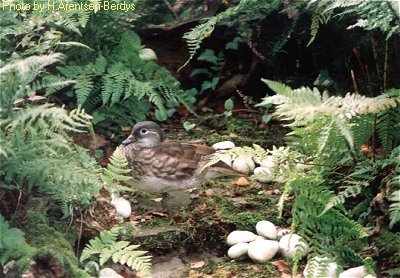[All pictures of garden wildlife on this page are thumbnails. Click on any thumbnail for a large format to be displayed.]
Mandarine Duck (Aix galericulata)

Our pond is a very small one. The Mandarine Duck belongs to the smallest of Ducks so somehow it fitted there.
One morning, getting out of bed and looking into the front garden, I was really astonished by the sight of a small duck in our garden. It was sitting there quietly. I was amazed however: why should a duck pick my garden en what duck is it? I studied all the books I have in my home, but even the photographes below didn't help me at the time.


As I never expected this type of duck to occur in my garden, it was difficult to identify it.
What puzzled me most was the size of the bird (it's a very small duck indeed), the little hook on the beak and the white line round the eyes. Finally I did what I should have done before: I took my pictures to a real expert of birds. He took his time and then declared that it was the female of the Mandarin Duck. When you look in most books about birds you will only see the male portraited, which is extremely colourful, with lots of orange and other striking colours. The female is often not shown. The species originates from Eastern Asia, but was imported in Europe hundreds of years ago. It was kept in zoos etc, but some individuals escaped and started colonies of their own, entirely in the wild. The species now succesfully breeds in England, Holland and the south of Germany. And according to recent reports the bird now has also conquered Scotland, where the natural conditions are similar to the places it lives in Asia, especially China. Despite the colourful appearance this is not a tropical bird at all. The one in my garden (it stayed there for one or two weeks only) could have been just an escaped bird, but it didn't have a ring, so it could just as well have been a wild one, who knows? Below you get an impression of how the male looks like The differences between male and female are enormous indeed.

A drawing of the beautiful male, which is very easy to identify.
| Name of this bird in various other languages | ||||
| Dutch | German | French | Polish | Scientific |
| Mandarijneend | Mandarinente | Canard mandarin? | Mandarynka | Aix galericulata |

© Copyright 1998-2024 gardensafari.net (Hania Berdys)

 English / engels
English / engels  Dutch / nederlands
Dutch / nederlands